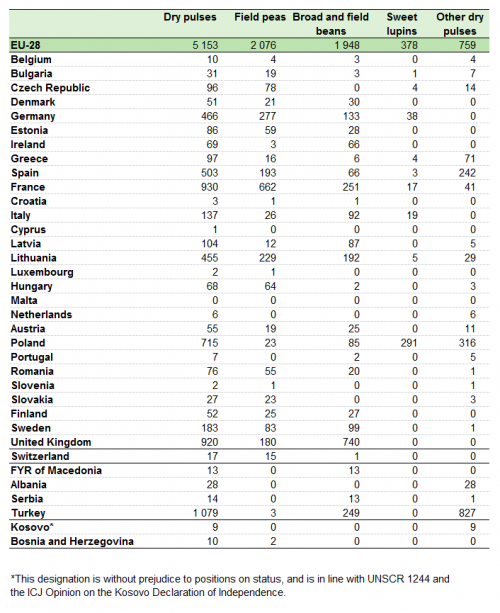Archive:Dry pulses in EU agriculture - statistics on cultivation, production and economic value
Data extracted in October and November 2016
No update is planned for this article
This article is outdated and has been archived. For recent articles on Agriculture, see here.
Author: Antonella De Cicco
Highlights
The area used to cultivate dry pulses in the EU increased by 64.7 % between 2013 and 2015.
In 2015, dry pulses were cultivated on 2.1 % of all EU arable land.
This article offers a statistical overview of the dry pulses sector in EU agriculture, and presents data on cultivated areas, harvested production, farms and the economic value of the sector.
Full article
Evolution of dry pulses area
New CAP measures boost production of dry pulses
The area used to cultivate dry pulses in the EU-28 has fluctuated between 1.5 and 2.1 million hectares over the last 10 years (Fig. 1). However, since 2013 the area has grown considerably. The increase between 2013 and 2015 was 64.7 % at EU-level and up to 350.7 % in Latvia, 253.6 % in Lithuania and 181.4 % in Bulgaria.
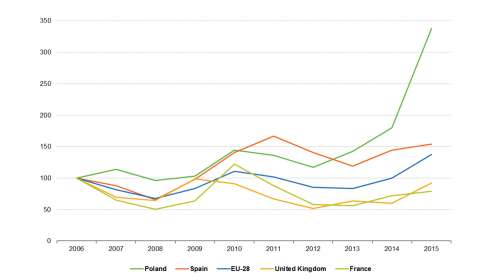
Source: Eurostat (apro_acs_a)
This is largely a result of the new Common agricultural policy (CAP) greening measures. The new CAP introduced the green direct payment scheme, which began to be implemented in 2015. In particular, nitrogen-fixing crops (such as dry pulses) are one of the options available for implementing the ecological focus areas [1]. In addition, 16 Member States decided to support the protein crop sector within the voluntary coupled support framework. In 2015, those Member States allocated a total of EUR 443 million to the protein crop sector, which was 11 % of the total voluntary coupled support ceiling fixed by the Commission. Farmers have responded to these measures by sowing larger areas with dry pulses.
Role of dry pulses in EU agriculture
Dry pulses are grown on 2.1 % of European arable land, and this has increased over the last three years
In 2015, the EU-28’s utilised agricultural area was 178.5 million hectares. The largest share (59.8 %) was devoted to arable land (107 million hectares), one third (33.2 %) was covered by permanent grassland and permanent crops were cultivated on 11.7 million hectares (6.6 %) .
Arable land was mainly cultivated for cereals (54.0 %). Green fodder crops were produced on 20.0 % of arable land, industrial crops covered 11.7 %, 6.6 % of land was fallow and root crops were grown on 2.8 % (Fig. 2).
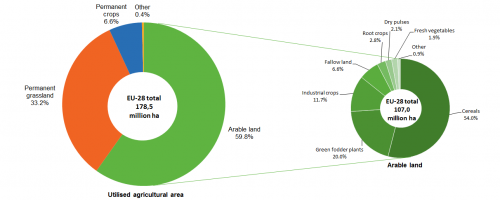
Source: Eurostat (apro_acs_a)
In 2015, dry pulses were cultivated on almost 2.2 million hectares, which was 2.1 % of all European Union arable land. In 2014, 1.5 % of all EU arable land was used for dry pulses compared with 1.1 % in 2013, while previously the share fluctuated smoothly on a yearly basis.
Dry pulses are cultivated in almost all EU Member States; the largest area (22.5 %) is in Spain
Dry pulses are grown in all Member States except Malta. However, there are some differences at individual Member State level: Lithuania registered the highest share of arable land dedicated to dry pulses (7.3 %), while in Belgium and Croatia that share was only 0.3 % (Map 1).
A quarter (22.5 %) of the area used to cultivate dry pulses in the EU-28 was located in Spain, followed by Poland (18.6 %), France (12.4 %) and the United Kingdom (9.8 %). This means that almost two thirds (63.3 %) of the area under dry pulses was located in four Member States (Table 1).

Source: Eurostat (apro_acs_a)
Field peas, broad and field beans are the leading pulses
Among the dry pulses, field peas covered more than one third (34.2 %) of the total area under dry pulses, and broad and field beans came second (28.7 %). Sweet lupins were grown on 11.9 % of the area and the diverse group of ‘other dry pulses’ (lentils, chick peas, beans, etc.) were present on the last quarter (26.4 %)[2].
Spain and France dominate the cultivation of field peas in the EU; the UK has the largest area for broad and field beans
Different Member States led the production of each single dry pulse crop. France was the leader in cultivating field peas, with a share of 23.6 %, Spain came second with 21.7 %, followed by Lithuania (10.7 %) and Germany (10.6 %).
The United Kingdom had the single largest share (27.2 %) for broad and field beans cultivation; France (13.8 %) and Lithuania (9.8 %) ranked second and third.
Poland is a clear leader in cultivating sweet lupins (80.6 %) followed by Germany (11.5 %). Almost half (47.7 %) of the area dedicated to ‘other dry pulses’ [3] was situated in Spain, while an additional one quarter (25.9 %) was in Poland.
Member States have different specialisation patterns in cultivating dry pulses
Some Member States specialised in producing certain dry pulses: field peas accounted for 90.7 % of the total area under dry pulses in Hungary, 74.0 % in Slovakia, 72.1 % in the Czech Republic and 70.6 % in Estonia. By contrast, field peas were cultivated on 7.5 % of dry pulse area in Ireland [4] and 3.0 % in Poland.
Broad and field beans were the dry pulses predominantly cultivated in Ireland (92.5 %), Latvia (82.3 %) and the United Kingdom (79.8 %), but covered only 0.6 % of total dry pulse area in Slovakia.
Sweet lupins were prevalent in Poland and were cultivated on more than half (51.4 %) of the dry pulse area.
The ‘other dry pulses’ covered two thirds of the dry pulse area in Greece (75.1 %) and accounted for more than half of the dry pulse area in Portugal (67.8 %), Cyprus (62.1 %) and Spain (55.9 %).
Production of dry pulses: 5 million tonnes
In 2015, the EU-28’s total harvest of dry pulses was 5.1 million tonnes (Table 2). Production in 2015 was 1.6 million tonnes higher than in 2014, an increase of 43.8 %. The 2015 dry pulse harvest was 50.6 % higher than the average production of 3.4 million tonnes registered in 2010-2014.
Field pea production was a little more than 2 million tonnes, accounting for 40.3 % of production volume, and broad and field bean production was 1.9 million tonnes (38 %). Sweet lupins accounted for 7.4 % of the total production volume of dry pulses.
In 2015, the EU-28 imported a total of 0.92 million tonnes of dry pulses, which was a 14.2 % less than in 2014 and 16.8 % less than the average of imported quantities registered in 2010-2014.
France and the United Kingdom are the largest producers
Four Member States produced over 3 million tonnes of dry pulses, which was a 59.6 % share of production volume. France, with 930 000 tonnes, was the largest EU producer of dry pulses and accounted for 18.1 % of production volume. This was almost equalled by the United Kingdom with 17.9 % of production volume. Poland accounted for 715 000 tonnes and ranked third (13.9 %), while Spain was fourth with 503 000 tonnes (9.8 %).
The fact that Member States rank differently for cultivation area and production is due mainly to France and the United Kingdom specialising in the more productive dry pulse crops (field peas and field and broad beans), while Spain cultivates large areas of the heterogeneous group of ‘other dry pulses’. In addition, the farms in both France and the United Kingdom that cultivate dry pulses are larger and are more likely to take advantage of scale economies.
France was the leading country for field pea production. It harvested 662 000 tonnes (31.9 % of production volume) and was far ahead of Germany (13.3 %), Lithuania (11.0 %) and Spain (9.3 %).
The United Kingdom, with 740 000 tonnes, was the main producer of broad and field beans (37.8 %), followed at some distance by France (12.8 %), Lithuania (9.8 %) and Germany (6.8 %).
Poland alone produced 291 000 tonnes of sweet lupins, which was 76 % of production volume, followed by Germany (10 %). ‘Other dry pulses’ were produced mainly in Poland (41.6 % of production volume) and Spain (31.8 %).
Structure of production
Almost 350 000 farms cultivate dry pulses; 90 % of the area is cultivated by farms with over 10 ha of arable land
According to the most recent farm structure survey (2013), 346 000 holdings in the EU cultivated dry pulses, which represented 3.2 % of all EU holdings. Four in five of these holdings (80.3 %) also cultivated cereals, probably for crop rotation. However, dry pulses were present on a 5.1 % share of holdings with cereals.
Production of dry pulses is intensive: larger farms (over 10 ha of arable land) cultivated 91.4 % of the EU dry pulses area, although they represent only 36.7 % of all farms with area under dry pulses (Figs. 3 and 4).
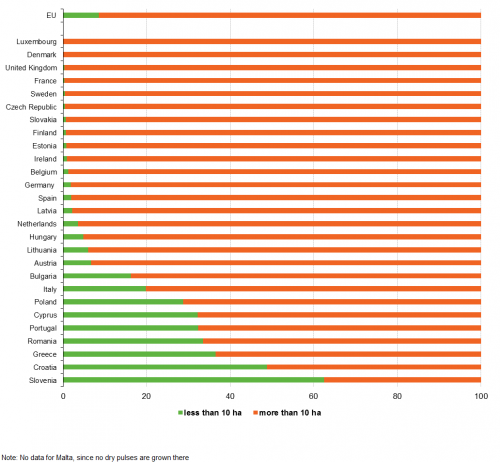
(% of total arable land)
No data for Malta, since no dry pulse is grown in there
Source: Eurostat (ef_alvege)
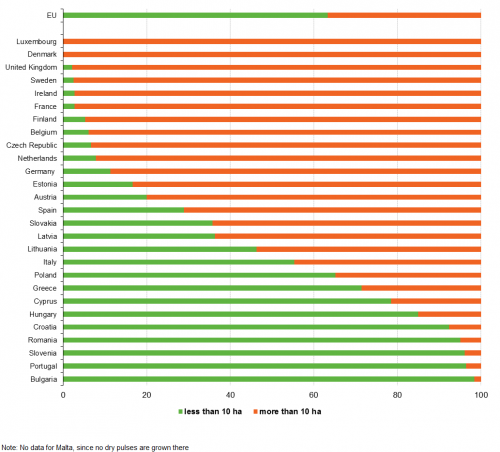
(% of farm holdings)
No data for Malta, since no dry pulse is grown in there
Source: Eurostat (ef_alvege)
The main producing Member States recorded higher shares both for the number of farms and for area. In the United Kingdom and France virtually all the dry pulses area (respectively 99.7 % and 99.6 %) was located in farms with 10 ha or more of arable land, which were respectively 97.9 % and 97.2 % of all dry pulses farms. The only exception was Poland where both shares were lower than the EU level (34.9 % for farms and 71.3 % for area).
The largest numbers of farms cultivating dry pulses were situated in Romania (28.8 %) and Poland (19.3 %). However Romanian farms cultivated only 2.4 % of the European dry pulse area. In contrast, the United Kingdom and France accounted for 0.1 % and for 0.3 % respectively of the number of farms, although those few farms cultivated 10.4 % and 15.7 % of the EU-28’s dry pulse area.
Organic dry pulses cover 2.2 % of the dry pulse area; Italy has the biggest share under organic production (20 %)
In 2015, the share of organic production was 2.2 % of the total area under dry pulses, while 7.9 % of farms cultivated organic dry pulses. Most of the farms with organic area dedicated to dry pulses were located in Italy (20.2 %), Germany (15.5 %), Austria (14.8 %) and France (12.8 %).
Economic value of dry pulses
Dry pulses’ output values: EUR 1 300 million (0.6 % of crop output)
The output value for dry pulses [5] in 2015 was EUR 1 317 million at basic prices, which was 0.32 % of the total agricultural output and 0.62 % of the crop output. The value for 2015 was 28 % higher than in 2014 and 41 % higher than in 2013.
The contribution of dry pulses to both agricultural and crop outputs also increased. In 2014, dry pulses accounted for 0.25 % of agricultural output and 0.49 % of crop output, while in 2013 these shares were 0.22 % and 0.42 %.
Half of the output value for dry pulses was created by Poland, France and the United Kingdom
One fifth of the output value for dry pulses was generated by Poland (22.5 %), while France accounted for 17.8 % and the United Kingdom for 13.1 %. This means that more than half (53.4 %) of the output value of EU dry pulse crops was created by three Member States (Fig. 5).
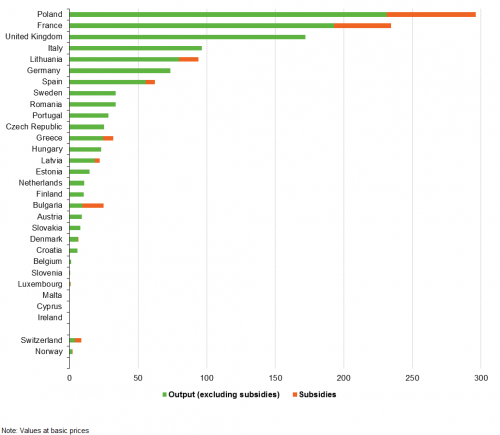
Source: Eurostat (aact_eaa01)
Despite its leading position in terms of area and its fourth place in terms of tonnes harvested, Spain ranked only seventh in terms of value with 4.7 % share.
Subsidies: EUR 154 million to dry pulses
In 2015, EUR 154 million in subsidies was provided to dry pulses at EU-28 level. This was 11.7 % of the output value of dry pulses at basic prices. In 2014 and 2013, subsidies to dry pulses were far lower than that amount: respectively EUR 90.7 and EUR 85.2 million. The subsidies to the dry pulses sector were registered in just nine Member States: among those Poland recorded the highest value (EUR 64.9 million), while France came second with EUR 41.5 million.
Source data for tables and graphs
Data sources
Statistics on crop production
Statistics on crop products are obtained by sample surveys, supplemented by administrative data and estimates based on expert observations. The sources vary from one EU Member State to another because of national conditions and statistical practices. National statistical institutes or Ministries of Agriculture are responsible for data collection in accordance with EC Regulations. The finalised data sent to Eurostat are as harmonised as possible. Eurostat is responsible for establishing EU aggregates. The statistics collected on agricultural products cover more than 100 individual crop products. Information is collected for the area under cultivation (expressed in 1 000 hectares), the quantity harvested (expressed in 1 000 tonnes) and the yield (expressed in 100 kg per hectare). For some products, data at a national level may be supplemented by regional statistics at NUTS level 1 or level 2.
Statistics on the structure of agricultural holdings (FSS)
A comprehensive Farm structure survey (FSS) is carried out by EU Member States every 10 years (the full scope being the agricultural census) and intermediate sample surveys are carried out twice between these basic surveys. The statistical unit is the agricultural holding; the EU Member States collect information from individual agricultural holdings, covering:
- land use;
- livestock numbers;
- rural development (for example, activities other than agriculture);
- management and farm labour input (including age, sex and relationship to the holder).
Survey data are aggregated to different geographic levels (countries, regions, and for basic surveys also districts) and arranged by size class, area status, legal status of holding, objective zone and farm type. In the FSS organic data has been collected since the 2000 Census.
Economic accounts for agriculture (EAA)
Data on EAA provide an insight into:
- the economic viability of agriculture;
- agriculture’s contribution to each EU Member State’s wealth;
- the structure and composition of agricultural production and input;
- the remuneration of factors of production;
- relationships between prices and quantities of both input and output.
The output of agricultural activity includes output sold (including trade in agricultural goods and services between agricultural units), changes in stocks, output for own final use (own final consumption and own-account gross fixed capital formation), output produced for further processing by agricultural producers, as well as intra-unit consumption of livestock feed products. The output of the agricultural sector is made up of the sum of the output of agricultural products and of the goods and services produced in inseparable non-agricultural secondary activities; animal and crop output are the main product categories of agricultural output. Eurostat also collects annual agricultural prices (in principle net of VAT) to compare agricultural price levels between EU Member States and to study sales channels. Quarterly and annual price indices for agricultural products and the means of agricultural production, on the other hand, are used principally to analyse price developments and their effect on agricultural income. Selling prices are recorded at the first marketing stage (excluding transport). Agricultural price indices are obtained by a base-weighted Laspeyres calculation (2010 = 100), and are expressed in nominal terms or as deflated indices based on the use of an implicit consumer prices (HICP) deflator.
Context
Dry pulses are edible seeds (dry grains) of annual plants in the leguminous family; they grow in pods each having between one and twelve grains, and have a variety of shapes, sizes and colours. Most common are peas and beans.
Dry pulses are key crops because of their high protein content and ability to fix atmospheric nitrogen in the soil. This means that dry pulses are a good source of protein both for livestock (fodder) and humans. Secondly, cultivating dry pulses increases the nitrogen level in the soil.
The 68th UN General Assembly declared 2016 the International Year of Pulses. The aim was to raise public awareness of the nutritional benefits of pulses and of their importance in sustainable food production. The Food and Agriculture Organization of the United Nations (FAO) focuses on 11 types of pulses[6] which are cultivated all around the world in different pedo-climatical conditions and agricultural systems. In Europe the most common are field peas, field and broad beans and sweet lupins harvested after the stage of lactic ripeness. Those crops are mainly cultivated for fodder.
The recently-reformed EU common agricultural policy (CAP)[7] aims at providing consumers with a stable, sustainably-produced supply of safe and quality food at affordable prices while preserving the natural resources necessary for agricultural productivity. Among other measures, the new CAP for 2014-2020 introduced the green direct payment scheme, a new policy instrument to enhance the sustainability of agriculture in the European Union. There are several ways in which farmers can be eligible for the new compulsory green direct payment scheme, and one is by cultivating nitrogen-fixing crops. Those crops, which include dry pulses, protect the soil from erosion and improve soil organic matter.
Direct access to
- Crops products: areas and production (ESMS metadata file — apro_acs_esms)
- Farm structure survey (ESMS metadata file — ef_esms)
- Economic Accounts for Agriculture (ESMS metadata file — aact_esms)
- Regulation (EC) No 1307/2013 Regulation (EU) No 1307/2013 of 17 December 2013 on establishing rules for direct payments to farmers under support schemes within the framework of the common agricultural policy and repealing Council Regulation (EC) No 637/2008 and Council Regulation (EC) No 73/2009.
- Summaries of EU Legislation: Rules for direct EU payments to farmers
- Regional Statistics Illustrated - select statistical domain 'Agriculture' (top right)
Notes
- ↑ Compulsory on 5 % of the holding arable area for those farmers with arable land exceeding 15 hectares
- ↑ The sum of shares does not total 100 % due to the estimation for sweet lupins
- ↑ The group ‘Other dry pulses’ includes dry common/French beans and runner beans, chick peas, dry lentils and dry vetches
- ↑ Data for Ireland include dry and fresh pulses
- ↑ The aggregate ‘protein crops’ in the EAA includes the same crop as ‘dry pulse and protein crops’ in annual crop statistics
- ↑ Dry beans, dry broad beans, dry peas, chickpeas, lupins, lentils, vetches, cow peas, pigeon peas, Bambara beans and pulses not elsewhere specified (i.e. minor pulses that do not fall into one of the other categories)
- ↑ Regulation (EU) No 1307/2013

